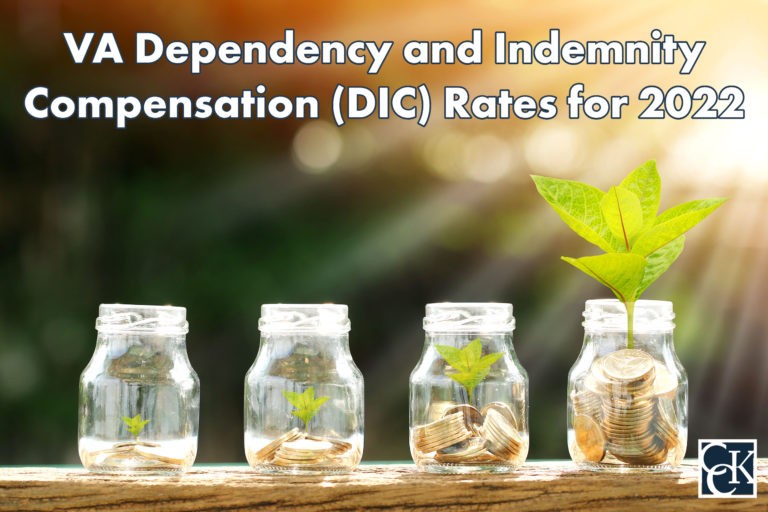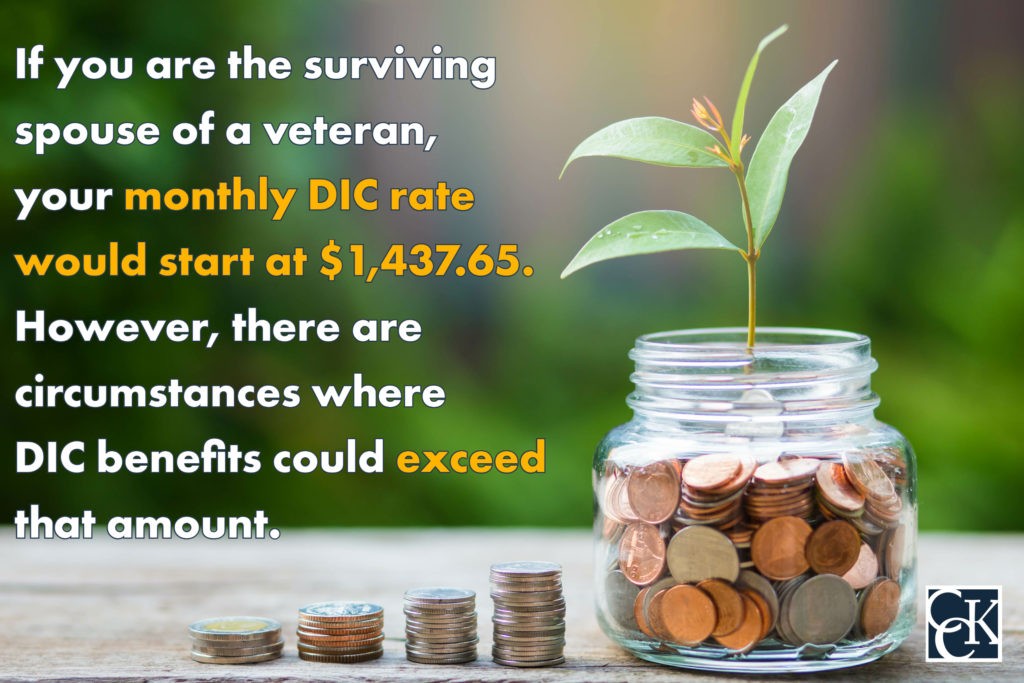VA Dependency and Indemnity Compensation (DIC) Rates for 2022

CCK Law: Our Vital Role in Veterans Law
What is Dependency and Indemnity Compensation (DIC)?
Dependency and Indemnity Compensation, or (DIC), is a tax-free, monthly benefit paid to a surviving spouse, children, and sometimes parents of a veteran whose death was related to military service or a service-connected condition. Notably, however, survivors are not paid the same monthly amount that the veteran was receiving at their time of death.
There are certain criteria that both the veteran and the survivor need to meet in order to qualify for DIC benefits. In order for the veteran to be eligible, one of the following must be true:
- “The servicemember died while on active duty, active-duty training, or inactive duty training;” or
- The veteran passed away due to a service-connected condition; or
- The veteran’s death was not service-related, but was entitled to receive VA disability compensation for a totally disabling condition (or total disability based on individual unemployability, TDIU):
- For a period of at least 10 years prior to death; or
- Since release from active duty and for a period of at least five years prior to the veteran’s death; or
- “For at least one year before death if the veteran was a former prisoner of war who died after September 30, 1999.”
There are also specific eligibility requirements for survivors, in order to receive DIC benefits. Surviving spouses are typically eligible for DIC benefits if:
- Married to the veteran for at least one year prior to the veteran’s death; or
- Had a child with the veteran; and
- Lived with the veteran continuously until the time of their death; and
- Were not separated from the veteran or, if separated, were not responsible for the separation
There may be additional circumstances where a survivor may qualify for DIC benefits. Importantly, VA will recognize common law marriages for DIC benefits if your state’s laws allow.

What Are the DIC Rates in 2022?
Every year, the Social Security Administration (SSA) releases a cost-of-living adjustment or COLA. This adjustment is based on the percentage increase in the Consumer Price Index for Urban Wage Earnings and Clerical Workers (CPI-W). The CPI-W measures the change in prices of goods and services over time.
While DIC has its own exclusive rates, DIC benefits tend to increase annually with the COLA rates. In 2021, DIC rates increased by 1.3 percent. For 2022, DIC rates will see a 5.9 percent increase, in correlation with the COLA rate increase.
For 2021, the DIC rate was $1,357.56. The 2022 DIC rate will be effective December 2021 and it will increase to $1,437.65. Importantly, dependents may also be eligible for added amounts based on certain factors, including the following:
How to Calculate DIC Payment Rates for 2022
As mentioned above, if you are the surviving spouse of a veteran, your monthly DIC rate would start at $1,437.65. However, there are circumstances where DIC benefits could exceed that amount.
For example, if the veteran had a school-age child, the monthly payment would include $301.74. Therefore, the monthly DIC rate would essentially equal $1,739.39.
If the veteran had a “helpless child,” the monthly payment would include $607.01. This would make the full monthly payment, including the DIC rate, $2,044.66.
Both of these examples would be if the veteran did have an eligible surviving spouse. If the veteran did not have an eligible spouse, these amounts will differ.
For instance, when the veteran did not have an eligible spouse but did have one eligible child, the monthly rate would be $607.01. If there are two eligible children, the monthly payment would be $1,137.36.
How to Apply for DIC Benefits
VA Form 21P-534EZ, or Application of DIC, Death Pension, and/or Accrued Benefits, is the official application which can be used to submit a claim for VA survivors benefits. The form is eight pages long and consists of 12 sections. In addition to this form, certain evidence will also need to be submitted to help substantiate the claim. Specifically, such evidence may consist of the veteran’s death certificate, marriage certificate (if applicable), and any divorce decrees from prior marriages.
Evidence relating to the veteran’s dependent children will also need to be submitted, such as birth certificates and school or college transcripts. VA requires the aforementioned documents when applicable and therefore, submitting these documents along with your application form can help expedite the adjudication process.
Do You Need Assistance Getting DIC Benefits?
Applying for DIC benefits can be a very lengthy and difficult process. As such, it may be beneficial to seek assistance from a Veteran Service Organization, VA-accredited claims agent, or VA-accredited attorney. Seeking assistance can ensure all the proper forms are completed and necessary evidence is submitted.
The experienced claims advocates at Chisholm Chisholm & Kilpatrick have helped survivors win their claims for DIC benefits and we may be able to help you. Contact our office today for a free consultation.
About the Author
Share this Post

